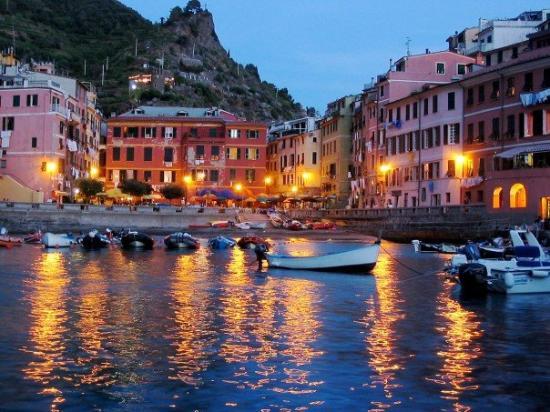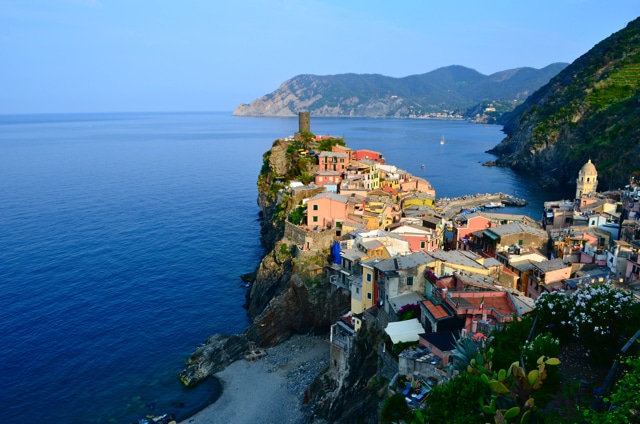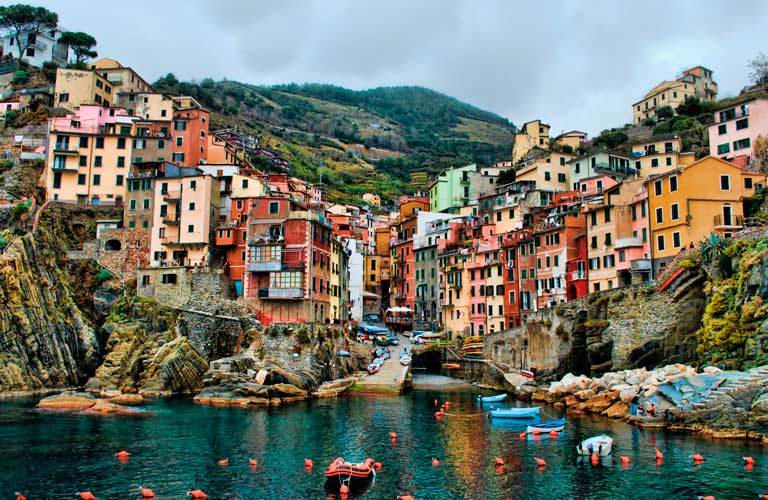A longer stay in Florence or in our Chianti Villa can be a base for visiting not only Chianti or the small villages such as Cortona or Impruneta but also seaside places such as Castiglioncello or the Cinque Terre.
Five miles of rocky coast in eastern Liguria, two promontories lie at each extremity, thousands of kilometers of dry walling, cultivated into vineyards, five southerly villages castled up on spurs of stone or disposed in clusters of very small inlets. These are the co-ordinates of the Cinque Terre (Five lands).
Recognized finally as a National Park in 1999 and UNESCO protected territory since 1997 as a system of naturalistic environmental interest. This zone is characterized by the presence of precipitous slopes which have been cultivated into vineyards by means of fatiguing system of terracing the only evidence of transformation operated by the laborious human activity on the territory.
The suggestive type of coastal projections on the sea with sheer cliffs that often overtake the verticality alternated with bays, winding paths and enchanting small beaches between cliffs with a profound back drop, a rich variety of ichthyic (fishing) all of which make this district an authentic natural “opera of art”.
Here, the five villages of Monterosso, Vernazza, Corniglia, Manarola, Riomaggiore make up the renowned Cinque Terre.
Over the years, the people have succeeded in imposing their will on this difficult landscape through terrace cultivation consisting of narrow strips of land on the hillside or sheer cliffs called “fasce”. Man has had to build countless short dry walls “muretti” and steps to support the steep strips of land. From a research carried out by naturalists it seems that, over thousands of years, the inhabitants of the Cinque Terre have carried out an enormous task in constructing and repairing these famous short dry walls “muretti”. So much so that the two-metre-high, eleven thousand kilometre long network of dry walls is comparable to the Great Wall of China.
Perhaps it is the hard work that the farmers have been carrying out for hundreds of years together with the air made salty by the sea spray on stormy days that have made the grapes so sweet and the olives and lemons so tasty.
The ancient “Etruscan Road” was brought back into use by the Romans, bringing both trade and commerce to the Cinque Terre. It was abandoned again during the rule of the Republic of Genoa and this might be a reason why the area has preserved all its natural and untouched beauty.
Even today, it is not easy to reach the five villages, arriving either by train or along the winding roads. However, these access difficulties are the surest guarantee for the preservation of this characteristic and unique landscape.
Monterosso al Mare is the westernmost of the Cinque Terre and is reached by walking along the most difficult part of the “Sentiero Azzurro” footpath.
The village is protected by hills covered with vineyards and olive groves and is surrounded by vegetation. Its beautiful beaches, steep rugged cliffs and crystal-clear waters, make this one of the most charming resorts on the Ligurian Riviera of the east.
The medieval tower “Aurora”, located on the hills of the Cappuccini, separates the ancient part of the village from the more modern part. In the church of Saint Francis “San Francesco” works of great importance such as the Crucifixion, believed by many to have been painted by Van Dyck, are preserved.
The village’s delightful hotels are popular for their warm and friendly atmosphere and the village’s restaurants offer customers the chance to try the local Ligurian dishes accompanied with the famous Cinque Terre wine.
A path with breathtaking views winding along Mediterranean groves and partly deserted fields and vineyards, reaches its peak on the route leading to Vernazza.
This village, founded around the 1st Century, in time acquired deep-rooted maritime traditions. Some examples of excellent architecture, such as loggias, arcades and portals are evidence of a standard of living that was economically and socially superior to that of the other villages of the Cinque Terre.
Corniglia is located on the ridge of a rocky promontory at the foot of a terraced vineyard. More concentrated on agriculture than on fishing, this farming community is very similar architecturally to inland agricultural villages. The parish church of Saint Peter, ‘San Pietro’, built in 1334 on the ruins of an old 11th century chapel, is one of the most beautiful, Gothic-Ligurian style monuments to be found in the Cinque Terre. It has been subsequently renovated but still retains a baroque overlay. Under the churchyard there is a black stone building with Gothic arches which is traditionally thought to be the ancient seat of the Fieschi family.
Manarola
There is a very beautiful footpath called the Lovers’ Pathway, “La Via dell’Amore”, which starts in Manarola. This high winding footpath, The Lovers’ Pathway, along the coast is a thirty-minute walk from Riomaggiore. This is a very ancient village, but it is difficult to give an accurate account of its history due to the lack of clear historical information. In a dominant position, overlooking the centre of the village is the church built in a Gothic style in 1338. Sheltered in a deep gorge between two promontory rocks, is the little port.
Riomaggiore is the easternmost of the Cinque Terre and is located in the narrow valley of the “rio Maior”, along whose course the village was born. Though maintaining its fishing and agricultural roots, tourism has become very important to the economic life of the village over the last few decades, partly due to its easy access from La Spezia.
The birth of the village, according to tradition, dates back to the 8th Century, when it was founded by group of Greek refugees who escaped the religious persecution of the Byzantine Emperor, LeoneIII ‘L’Isaurico’. The earliest historical information concerns its transfer from the hands of the Fieschi family to the Republic of Genova in 1276. The village has an urban layout made up of a series of footpaths which follow the outline of the land. These steep footpaths allow direct access to the upper floors of some of the houses, the oldest of which are tower-like and built vertically in parallel clusters. Overlooking the village is the parish church of Saint John the Baptist, ‘San Giovanni Battista’, built in 1340 by the Bishop of Luni. In 1870, the facade began to crumble and was rebuilt in the Gothic style. Nearby is the house where Telemaco Signorini stayed on a number of occasions after 1870. Characteristic features of the village were portrayed in many of his paintings. Down below is the 16th Century “Oratory of the Disciplined” while high up on the opposite side of the village are the remarkable ruins of the 15-16th Century castle where the old cemetery was situated. There is a very beautiful footpath called the The Lovers’ Pathway, “La Via dell’Amore”, which starts in Riomaggiore.
Visit the 5Terre is an extensive full day excursion. We suggest you to get the train in early morning and come back for late dinner starting from the station of Campo di Marte just a few hundreds meters from Villa Landucci. As an alternative, get your car and drive up to LaSpezia, than get the local 5Terre Express. Do not drive up to there as the parking is basically impossible.










